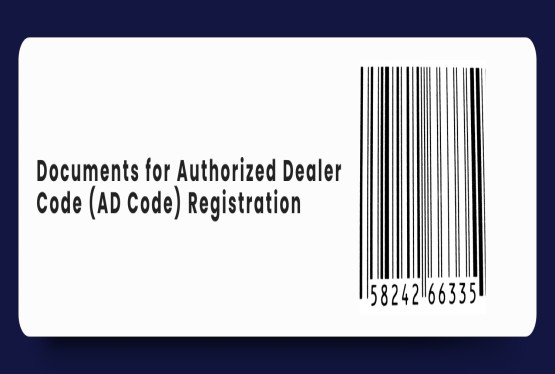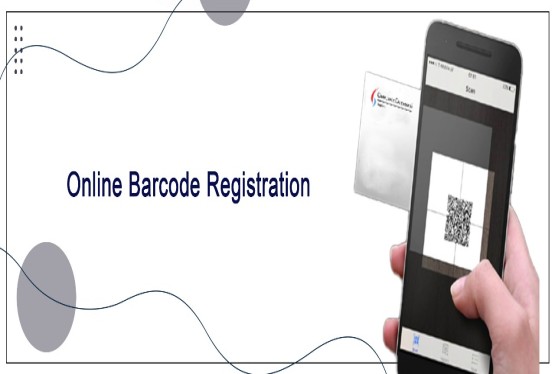Consumer expectations are constantly evolving in the cosmetic industry, the demand for transparent, traceable, and trustworthy products is more significant than ever. This shift has made Barcode Registration in Cosmetics Industry not just a compliance step but an operational necessity. Whether you are an emerging brand or a well-established cosmetic giant, barcoding your products enhances brand integrity, supports logistical efficiency, and elevates customer satisfaction, especially in an e-commerce-dominated marketplace.
Barcodes are more than just black lines printed on product packaging; they are the digital identity of your products in the supply chain. As consumers increasingly rely on digital retail platforms, barcode registration provides the backbone for quick identification, inventory tracking, and supply chain management. This article elaborates on why barcode registration is important in the cosmetics industry, its benefits, and how to implement it effectively for your beauty brand.
Barcodes on Cosmetic Products
Barcodes play a vital role in the cosmetics sector by offering a dependable system to track, manage, and verify products throughout their lifecycle. These machine-readable codes support both online and offline retail, ensuring accurate data capture and secure transactions. By embedding barcodes on packaging, cosmetic brands can meet modern consumer demands for transparency and regulatory requirements for safety.
Barcodes visually represent encoded product data, making it easy for machines to interpret and process. In the cosmetic industry, they are critical for precise inventory handling, product traceability, and quality assurance. From warehouse to retail shelf, barcode systems help ensure only verified products reach the market, protecting consumers from fake or substandard items.
Roles of Barcodes in the Cosmetic Industry
The following are the roles of barcodes in the cosmetic industry:
Streamlining Inventory Management
Barcodes simplify inventory management by providing unique identifiers for each product. This enables real-time tracking and updates, reducing errors and inefficiencies. With barcodes, inventory levels can be monitored accurately, ensuring that products are always available when needed and reducing the risk of overstocking or stockouts.
Enhancing Traceability and Authenticity
Barcodes enhance the traceability of cosmetic products from manufacturing to the end-consumer. They provide a transparent record of a product’s journey through the supply chain, making it easier to verify its authenticity. This is crucial for preventing counterfeit products from reaching consumers and ensuring that they receive high-quality, genuine items.
Importance of Barcodes in Ensuring Consumer Safety
Barcodes help trace the product’s journey from production to the retail shelf, ensuring that each item meets quality standards and regulatory requirements. This traceability is crucial for quick responses to safety recalls and for verifying the authenticity of products, thus protecting consumers from counterfeit items.
Traceability and Authenticity
Barcodes enable tracking of cosmetic products from their origin, ensuring that all items can be traced back to their manufacturing source. This capability is essential for identifying and removing counterfeit products from the market, thus protecting consumer health and maintaining brand integrity.
Compliance with Regulatory Standards
Barcodes ensure that cosmetic products comply with industry regulations and standards. They facilitate accurate labelling and packaging, which includes essential information such as ingredients, expiration dates, and batch numbers. This compliance meets legal requirements and assures consumers of the product’s safety and quality.
Types of Barcodes Used in Cosmetics
The following are the different types of Barcodes used in cosmetics:
One-Dimensional (1D) Barcodes
1D barcodes, such as UPC and EAN codes, are commonly used in the cosmetic industry for tracking and inventory management. These linear barcodes store limited information and are primarily used for retail products where space is a constraint.
Two-Dimensional (2D) Barcodes
2D barcodes, including QR codes and Data Matrix codes, are increasingly popular in the cosmetic industry. These barcodes can store a significant amount of data, including URLs and detailed product information. Their compact size and enhanced data capacity make them more versatile than 1D barcodes.
Implementation of Barcodes in Cosmetic Products
Let’s discuss the implementation of barcodes in cosmetic products:
Choosing the Right Barcode Technology
Selecting the appropriate barcode technology depends on various factors, such as the type of cosmetic product, packaging material, and the level of detail required in the barcode. For instance, 1D barcodes are suitable for basic tracking, while 2D barcodes are ideal for providing detailed product information and engaging consumers.
Register Your Barcodes
To ensure the uniqueness and global validity of your barcodes, registration with an authorized body like GS1 is essential. GS1 is an international organization that issues unique barcode numbers accepted by retailers and distributors worldwide. Once registered, your barcodes become identifiable across supply chains globally. Barcode Registration in Cosmetics Industry requires this step to comply with global standards and to avoid duplication or rejection of barcodes in international markets.
Packaging Product Design
The placement of barcodes on cosmetic packaging must be strategic. Barcodes should be clearly visible, scannable, and not distorted by design elements. However, they should also blend seamlessly with the product’s aesthetic. It’s advisable to consult a professional packaging designer who can maintain a balance between utility and visual appeal. Barcode Registration in Cosmetics Industry requires barcodes to be part of the packaging in a way that they serve their function without compromising brand image.
Integrating Barcodes into the Production Process
Integrating barcodes into the production process involves several steps, including selecting the right barcode format, using appropriate printing technology, and ensuring compatibility with existing inventory management systems. This integration requires collaboration with suppliers and investment in barcode generation software to ensure seamless implementation.
Testing Barcodes
Before launching your cosmetic products in the market, barcode readability must be tested using retail-grade scanners. Poorly printed or misaligned barcodes can result in scanning failures, leading to delays at billing counters and unhappy customers. Barcode Registration in Cosmetics Industry includes the essential step of verifying barcode functionality across different platforms and scanning devices. Testing ensures that barcodes work as expected during actual retail transactions.
Benefits of using Barcodes for Cosmetic Products
Benefits of using barcodes for cosmetic products are mentioned below:
Improved Inventory Management
Barcodes facilitate real-time tracking of inventory, reducing errors and inefficiencies in stock management. This leads to better forecasting, reduced stockouts, and optimized inventory levels, ultimately improving overall operational efficiency.
Enhanced Consumer Trust
By providing transparent and accessible product information through barcodes, brands can build consumer trust. Scanning a barcode allows consumers to verify product authenticity and access detailed information about ingredients and manufacturing processes, ensuring they are making informed choices.
Successful Implementation Stories
Various cosmetic brands have successfully implemented barcode systems to enhance their operations. These brands have experienced improved inventory accuracy, faster recall processes, and increased consumer trust, demonstrating the tangible benefits of using barcode technology.
Lessons Learned from Industry Leaders
Industry leaders in cosmetics have shared valuable insights and best practices for barcode implementation. These include the importance of selecting the right barcode type, investing in quality printing technology, and training staff on barcode usage and troubleshooting.
Future Trends in Cosmetic Barcodes
The future trends in cosmetic barcodes are:
Advances in Barcode Technology
Emerging technologies are set to revolutionise barcode usage in the cosmetic industry. Innovations such as enhanced data capacity, improved readability, and integration with digital platforms are expected to further streamline operations and enhance consumer engagement.
Impact of Digital Transformation
The integration of barcodes with IoT and blockchain technologies is transforming the cosmetic industry. These advancements provide enhanced traceability, secure data management, and real-time product tracking, paving the way for a more transparent and efficient supply chain.
Conclusion
Barcode Registration in Cosmetics Industry has emerged as a non-negotiable aspect of modern business operations. From enhancing transparency and trust to improving supply chain visibility and consumer safety, barcodes play an important role. They are indispensable for stock management, quick billing, and combating counterfeit goods. In a sector as sensitive and fast-paced as cosmetics, barcodes provide a standardized way to streamline product information and meet regulatory norms.
Moreover, many countries have regulations mandating barcode labeling on cosmetic products to ensure traceability and safety compliance. By adopting barcode registration, cosmetic companies not only protect their brand integrity but also improve customer experience and supply chain responsiveness. As the beauty industry becomes increasingly digital, implementing barcodes is the next step toward future-ready operations.
For any queries, connect with experts through:
Email: info@ccoffice.in
Call/Whatsapp: +91 9988424211
FAQs
Q1. What is barcode registration in the cosmetics industry?
Ans. Barcode registration in the cosmetics industry refers to the process of assigning unique machine-readable codes to cosmetic products and registering them with an authorized agency like GS1. This helps in product identification, inventory tracking, and ensuring authenticity throughout the supply chain.
Q2. Why is barcode registration important for cosmetic products?
Ans. Barcode registration is important because it ensures each product has a unique identity, helps track inventory in real time, enhances product authenticity, and prevents the circulation of counterfeit cosmetics. It also helps brands comply with industry regulations and maintain consumer trust.
Q3. Which types of barcodes are used in the cosmetic industry?
Ans. The cosmetic industry uses mainly two types of barcodes:
-
1D Barcodes like UPC and EAN, suitable for basic retail tracking.
-
2D Barcodes like QR and Data Matrix codes, which can store more information and are used for detailed product data and customer engagement.
Q4. How do barcodes help prevent counterfeit cosmetic products?
Ans. Barcodes and QR codes help verify a product’s origin and details, making it difficult for counterfeiters to replicate genuine product data. This authentication helps protect consumers and ensures the brand’s reputation remains intact.
Q5. Is barcode registration mandatory for cosmetic products?
Ans. In many countries, barcode registration is either mandatory or highly recommended for compliance with regulatory standards. It helps in accurate labeling, traceability, and meeting packaging norms required by government authorities.
Q6. How do barcodes improve inventory management in cosmetic businesses?
Ans. Barcodes automate inventory tracking, reduce manual errors, and enable real-time stock updates. This helps businesses avoid stockouts or overstocking, streamline supply chain operations, and improve overall efficiency.
Q7. Can consumers use barcodes to check cosmetic product details?
Ans. Yes, consumers can scan barcodes—especially QR codes—on cosmetic packaging using smartphones to access detailed product information such as ingredients, expiry date, manufacturer details, and authenticity verification.
Q8. What is the role of GS1 in barcode registration?
Ans. GS1 is an international body that issues unique barcode numbers used worldwide. Registering with GS1 ensures your cosmetic product barcodes are globally accepted, non-duplicated, and recognized across different retail and supply chain systems.












_crop10_thumb.jpg)





_crop10_thumb.jpg)




























-Form_crop10_thumb.jpg)

_crop10_thumb.jpg)























_learn_crop10_thumb.jpeg)
































_crop10_thumb.jpg)

_crop10_thumb.jpg)





















_crop10_thumb.jpg)















_for_Foreign_Directors_learn_crop10_thumb.jpeg)




_Act,_2015_learn_crop10_thumb.jpg)


































_learn_crop10_thumb.jpg)

































